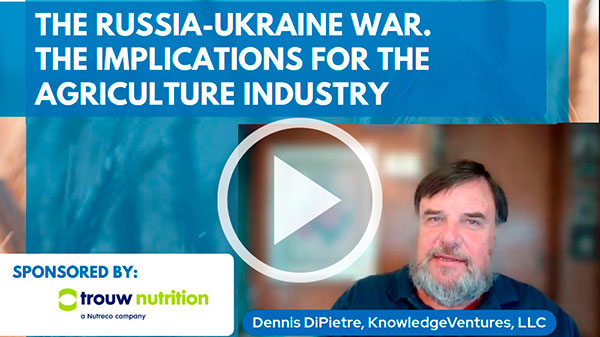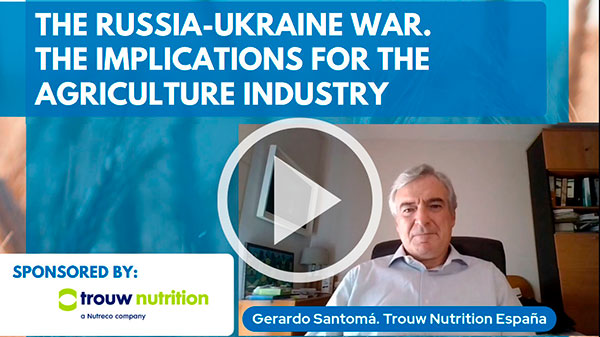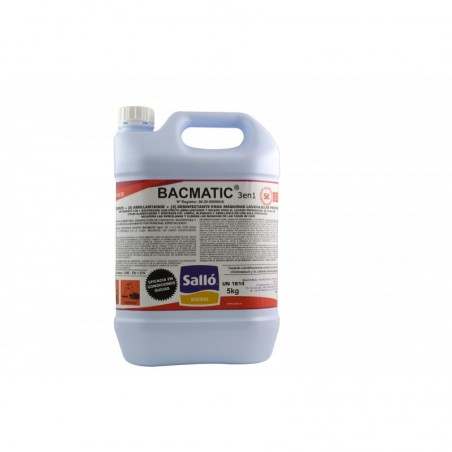The Russia-Ukraine War. The Implications for the agriculture industry – Dennis DiPietre [2:51]
Dennis DiPietre discussed the impact of the current war with respect to feed ingredients, energy, and fertilizers. He also forecasted costs and profits for pig production in 2022.
Impacts of the conflict on Ukrainian agriculture [7:14]

- Key Ukrainian ports disrupted
- Key crop-producing areas of the country occupied by Russian troops
- Ukraine’s cereal and grain production this year expected to be 17% - 50% less
- It is planting season and many roads are blockaded
- If planting is missed there will a decrease in export activity in Russia and Ukraine
- Ukraine will stop most exports of food and cereal grains to ensure the country has enough to feed its people
What kinds of global exports will be impacted by this military disruption? [14:03]
- Belarus: Fertilizer exports, especially nitrogen, will be impacted. Prices will rise.
- Belarus accounts for almost 6% of global fertilizer exports
- Ukraine: Cereal exports will be impacted
- Ukraine represents a 7.9% weighted average of all cereals
- Russia: Many exports impacted – Fertilizer, cereals, oil, fuel, and gas
Which countries depend on these affected resources? [16:07]
- Turkey - wheat from Russia
- Germany, Italy, Poland and Finland import energy from Russia
- Big impact on the poor when it comes to importing cereals from Russia: Vietnam, Yemen, Nigeria, Bangladesh, Egypt
How has the world responded to the conflict? [19:16]
- Bilateral attempt to sanction Russia financially for its actions
- Financial restrictions and attempts to lower the value of the ruble
- U.S. stopped purchasing oil from Russia and the U.K. has begun that process
- EU sanctions involving trade and restricting the ability from Russia to borrow funds. Restriction of flights for both cargo and others.
- Russia’s response: Demanding that goods, especially oil, be purchased in rubles to stabilize its currency.
Impacts of the sanctions on fertilizer [24:59]
- Reduction on fertilizer exports out of Russia and Belarus expected to reduce global crop production. Especially corn and some of the grains.
- Nearly 20% of all fertilizer is exported from Russia and Belarus alone
- Who receives that fertilizer? Brazil, India, United States, France, and Australia
- 60% of global oil seeds exports and 38% of cereals impacted by Russian fertilizer
How are these impacts reflected in prices? [27:30]
- Nitrogen fertilizer in the form of urea: huge increase before the conflict related to COVID blockages. Then prices took off because of disruptions due to conflict.
- U.S. soybean meal futures increased due to the invasion
- U.S. corn at all time high of $8 a bushel – will be disruptive for animal agriculture
- Costs for machinery, repairs, expansion, transportation, utilities, to remain high because of the conflict
- Fuel: utilities, electricity, LP gas, crude oil. to increase
What does this mean for profitability in the swine sector? [31:15]
- U.S. July wheat futures: February big spike up related to the invasion
- U.S. corn futures: at end of February there was gaping activity and then a new plateau. Hit $318 per metric ton (295 euros).
- U.S. July soybean futures: leaped up to about $621 per ton (575 euros)
- Lean hog contracts at 2.49 euros/kg as a result of high inflation, the cutback in production because of high input costs
- U.S. plants under capacity keeping prices very high
Costs are rising but so are pig prices. How is that going to impact profits? [34:20]
- Purchase price per head of hogs to peak in July, and then to fall off into the winter months
- Soybean meal expected to moderate toward the end of the year. Corn expected to continue to rise. Fuel prices to remain high. Fertilizer prices to go up and remain high through the end of the year. Steel likely falling after midyear.
- Profits are expected in the coming months until September when profitability could start to be challenged.
- If the increase in the value of manure as fertilizer is considered, the profits are much better.
- Europe: Feed cost expected to go up but level off. [41:28]
- EU average pig prices expected. Summer seasonal and then fall into winter months
- Fertilizer prices in the European Union expected to gradually fall
- EU producers to expect a small loss or maybe break even for the rest of the year
- Slightly below break-even even in the most profitable months of the summer if manure not considered
- Exploiting the value of manure could lead to profitable periods, especially in summer, and mitigate some of the downside in the lower price times in the fall.
Nutritional proposals to mitigate the impact of high costs in animal production – Gerardo Santomá [44:09]
Gerard Santomá made some nutritional proposals to face the current raw material crisis.
Increment on the raw material prices and impact on cost of production [44:50]
How to take better care of feed cost? [46:47]
- Animals are performing between 30 to 40% lower than their genetic potential→ Construct task force teams to look at the limiting factor
- We have to focus not only on minimizing the cost, but also do it in a sustainable way
Areas where we can work regarding animal nutrition:
- Precision nutrition methods [49:13]
- Raw Material Matrix [50:18]
- Update your raw material database
- Make it more dynamic to handle variation
- Introduce more nutrients
- Nutrient specifications [55:10]
- Consider energy levels in the diet
- Consider amino acid levels in the diet
- Limits on ingredient levels [57:39]
- Nutritional
- Technological
- Commercial
- Alternate ingredients- Co-products [59:20]
- Feed additives [1:00:17]
Intestinal health management and feed additives: a change in paradigm [1:01:15]









